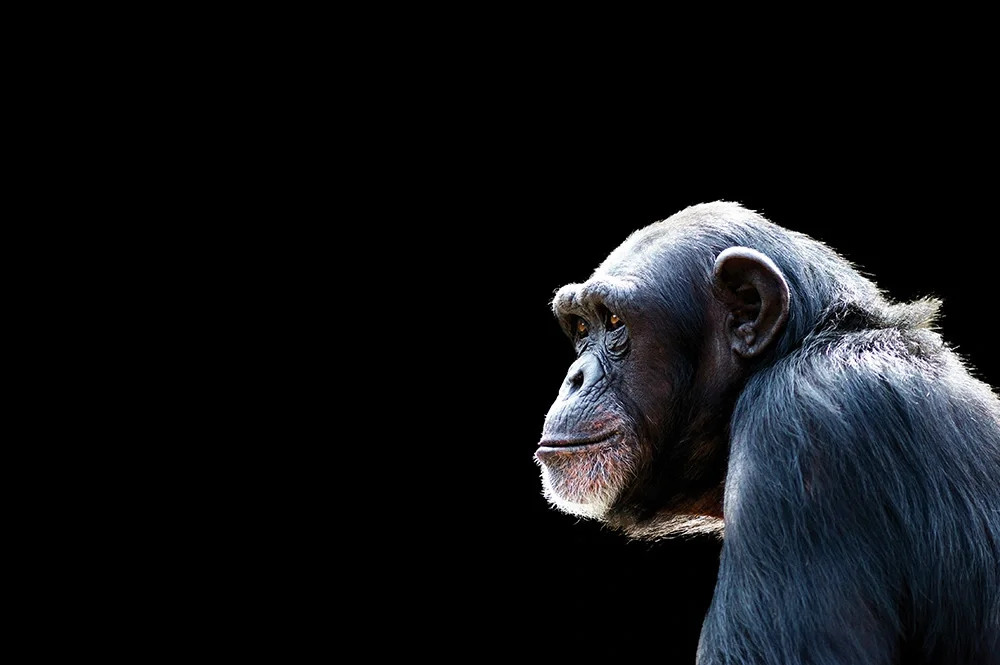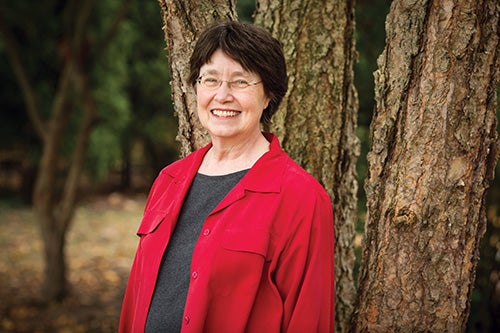

Jane Desmond remembers the day she and several colleagues drove to the great ape center in Des Moines to visit Kanzi, a bonobo who is one of the first non-human primates to show an understanding of human language.
The center’s researcher asked Kanzi if his visitors could take photos of him. But Kanzi, communicating through printed symbols, said, “No photos.” Instead, the ape signaled that he wanted a ball.
When Desmond and the others indicated that they didn’t have a ball, Kanzi kept demanding it. And when they said they were going to leave to buy a ball, Kanzi said, “Want ball now.”
“It was a shocking moment when he said ‘now,’” said Desmond, a pioneer in animal studies and an LAS anthropology professor since 2007. She is also director of the Human-Animal Studies at Illinois Initiative, which sponsors the annual International Summer Institute in Animal Studies, through the Center for Advanced Study.
Desmond’s interaction with Kanzi is just one among her many animal encounters, for she has studied animals from a variety of unique angles. For instance, she has examined pet cemeteries and ways people grieve animals, methods of displaying animals in death through taxidermy, and even animals that paint.
Most recently, she completed a 30-week fellowship in bioethics at Harvard Medical School, tackling ethical issues in both human and animal medicine. Each year, Harvard selects 15 professionals from around the world who are working in arenas with bioethical components.

The 2023-24 team included a pediatric heart surgeon, an ophthalmologist, the head of research at a major Boston hospital, and a liver transplant surgeon. Desmond was the only person in the group studying animals; she said her goal was to examine ways that veterinarians can learn from medical professionals working with humans.
“Medical anthropology, the study of health systems in communities around the world, is a very well-developed field,” Desmond said. “But there’s practically nothing in this branch of anthropology that engages with medicine for animals. I’m interested in a unique slice that most people are not working on.”
Desmond’s path to animal studies is equally unique. She began as a modern dancer and choreographer, teaching at Cornell and Duke. After retiring from performing, she earned a PhD in American cultural studies from Yale.
Her dissertation became a book, “Staging Tourism,” which examined cultural tourism and also “animal tourism,” which includes looking at animals in zoos and marine parks and through eco-tourism. “That’s when I got very involved in animal studies, which was just emerging as an interdisciplinary academic field.”
When Desmond came to U of I, she began teaching LAS courses on animal studies. Then, roughly 10 years ago, she started doing field work at the U of I College of Veterinary Medicine, where she is also affiliate faculty. “I have spent a lot of time shadowing vet students as they move through classrooms and into anatomy labs and clinics.”
On the surface, veterinary clinics appear much like hospitals for humans. But there are fundamental differences, such as tougher access to animal health care in some areas. She said the veterinary profession has begun to map “veterinary deserts”—places where access to vets is difficult. And even when you can reach a vet, can you afford it? Most people don’t have pet health insurance—and vet bills can be high.
In the bioethics realm, vets also face “inappropriate requests for euthanasia.” For instance, some pet owners will say they’re moving, and the new landlord doesn’t allow pets, so they want their animal euthanized. Or they don’t think their pet will be happy with another person, so they ask for the animal to be put to sleep.
“These requests are huge sources of moral stress for vets,” she said. It could be one reason that veterinarians have higher rates of suicide compared to the general population—even when compared to MDs.
After grappling with such ethical dilemmas during the Harvard fellowship program, Desmond came away with a hope to forge more links between professionals who treat animals and those working with humans. For instance, she wants to find out if veterinary faculty are interested in “ethical rounds”—processing ethical dilemmas as they do in hospitals.
Desmond has been encountering animals in unexpected ways ever since her mother rescued a robin that fell from a nest and brought the bird into their house for several years. However, her encounter with Kenzi stands out.
According to Desmond, they ran out and purchased a ball, as Kenzi requested. And when they presented the ball to him, Kenzi used his symbols to respond. The center’s researcher interpreted Kenzi’s reaction, which Desmond has never forgotten: “He said you can take a picture of him now.”
Editor's note: This story first appeared in the Fall 2024 issue of The Quadrangle.


